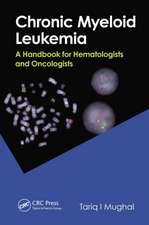Targeted Drug Strategies for Cancer and Inflammation
Editat de Ann L. Jackman, Christopher P. Leamonen Limba Engleză Paperback – 30 sep 2014
| Toate formatele și edițiile | Preț | Express |
|---|---|---|
| Paperback (1) | 1092.99 lei 43-57 zile | |
| Springer – 30 sep 2014 | 1092.99 lei 43-57 zile | |
| Hardback (1) | 1095.73 lei 43-57 zile | |
| Springer – 5 mai 2011 | 1095.73 lei 43-57 zile |
Preț: 1092.99 lei
Preț vechi: 1150.52 lei
-5% Nou
Puncte Express: 1639
Preț estimativ în valută:
209.15€ • 218.92$ • 174.07£
209.15€ • 218.92$ • 174.07£
Carte tipărită la comandă
Livrare economică 31 martie-14 aprilie
Preluare comenzi: 021 569.72.76
Specificații
ISBN-13: 9781489988867
ISBN-10: 1489988866
Pagini: 272
Ilustrații: XI, 254 p. With 1 4-page color insert.
Dimensiuni: 155 x 235 x 14 mm
Greutate: 0.39 kg
Ediția:2011
Editura: Springer
Colecția Springer
Locul publicării:New York, NY, United States
ISBN-10: 1489988866
Pagini: 272
Ilustrații: XI, 254 p. With 1 4-page color insert.
Dimensiuni: 155 x 235 x 14 mm
Greutate: 0.39 kg
Ediția:2011
Editura: Springer
Colecția Springer
Locul publicării:New York, NY, United States
Public țintă
ResearchDescriere
Folate pathways are essential in metabolism and macromolecule synthesis. Antifolate drugs that are largely transported via a high capacity folate transporter (i.e. the reduced-folate carrier) and inhibit folate-dependent enzymes include the dihydrofolate reductase inhibitor, methotrexate, and the thymidylate synthase inhibitors, raltitrexed and pemetrexed. Major advances in folate research made within the last decade include (i) the approval of pemetrexed for the treatment of lung cancer and mesothelioma, and (ii) the demonstration that cell membrane-anchored folate receptors (FR) are exploitable for cancer and inflammatory disease management. FRs are not widely distributed in normal tissues, except on some luminal surfaces; however, they are accessible to systemically administered agents when expressed on many cancers as well as on activated macrophages involved in various inflammatory diseases. High affinity folate-radioisotope conjugates have been developed for imaging pathogenic FR-positive diseases, including cancer. Since the FR transports folates via a low capacity but high affinity endocytic pathway, a variety of FR-targeted antifolate drugs and folate conjugates bearing a wide range of payloads (including cytotoxic drugs) are currently being developed which exploit this property. The FR is also being utilized in immunotherapy approaches for the treatment of overexpressing cancers.
Cuprins
Biological Role, Properties and Therapeutic Applications of the Reduced Folate Carrier (RFC-SLC19A1) and the Proton-Coupled Folate Transporter (PCFT-SLC46A1).- Folate Receptors and Therapeutic Applications.- Hormonal Control of Folate Receptor Genes.- Folate Receptor Targeted Radionuclide Imaging Agents.- Folate receptor targeted thymidylate synthase inhibitors.- Discovery of novel antifolate inhibitors of de novo purine nucleotide biosynthesis with selectivity for high affinity folate receptors and the proton-coupled folate transporter over the reduced folate carrier for cellular entry.- Folate-receptor targeted cancer chemotherapy.- Anti-FR antibody generation and engineering: development of new therapeutic tools.- Folate Receptor Positive Macrophages: Cellular Targets for Imaging and Therapy of Inflammatory and Autoimmune Diseases.- Targeting Activated Macrophages via a Functional Folate Receptor for Potential Treatment of Autoimmune/Inflammatory Disorders.-
Textul de pe ultima copertă
The discoveries highlighted in this book parallel the emergence of innovative “molecular targeted” small molecules and monoclonal antibodies, i.e. agents that target proteins within highly activated signal transduction pathways that control proliferation. Many of the tumor-targeted strategies described within cross the boundaries between what’s considered to be “molecular targeted” versus conventional systemic therapy. However, the main theme of this volume is the folate receptor (FR), with much of the content focused on its basic biology and regulation as well as its exploitation for targeted therapy and diagnostic imaging.
Caracteristici
Comprehensive focus on the folate receptor and its exploitation for targeted therapy and diagnostic imaging
Describes the boundaries between what’s considered to be “molecular targeted” versus conventional systemic therapy
Discussing discoveries that parallel the emergence of innovative “molecular targeted” small molecules and monoclonal antibodies, i.e. agents that target proteins within highly activated signal transduction pathways that control proliferation
Describes the boundaries between what’s considered to be “molecular targeted” versus conventional systemic therapy
Discussing discoveries that parallel the emergence of innovative “molecular targeted” small molecules and monoclonal antibodies, i.e. agents that target proteins within highly activated signal transduction pathways that control proliferation













